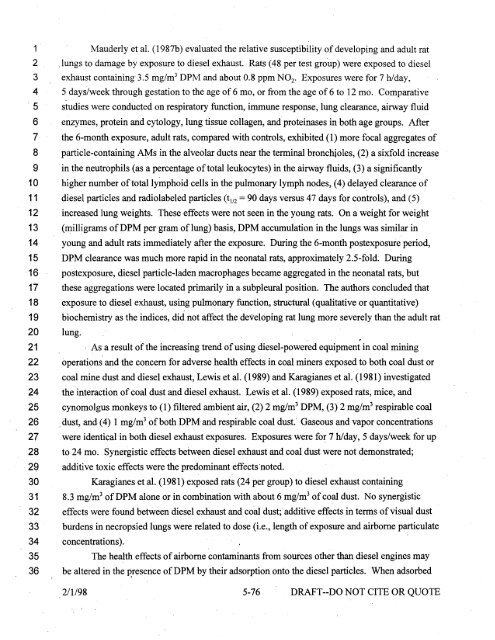Health Assessment Document for Diesel Emissions - NSCEP | US ...
Health Assessment Document for Diesel Emissions - NSCEP | US ...
Health Assessment Document for Diesel Emissions - NSCEP | US ...
Create successful ePaper yourself
Turn your PDF publications into a flip-book with our unique Google optimized e-Paper software.
1 Mauderly et al. (1987b) evaluated the relative susceptibility of developing and adult rat<br />
2 .lungs to damage by exposure to diesel exhaust. Rats ( 48 per test group) were exposed to diesel<br />
3 exhaust containing 3.5 mg/m 3 DPM and about 0.8 ppm N0 2 • Exposures were <strong>for</strong> 7 hlday,<br />
4 5 days/week through gestation to the age of 6 mo, or from the age of 6 to 12 mo. Comparative<br />
· 5 studies were conducted on respiratory function, immune response, lung clearance, airway fluid<br />
6 enzymes, protein and cytology, lung tissue collagen, and proteinases in both age groups. After<br />
7 the 6-month exposure, adult rats, compared with controls, exhibited (1) more focal aggregates of<br />
8 particle-containing AMs in the alveolar ducts near the terminal bronchioles, (2) a sixfold increase<br />
9 ·in the neutrophils (as a percentage of total leukocytes) in the airway fluids, (3) a significantly<br />
10 higher number oftotallymphoidcelis in the pulmonary lymph nodes, (4) delayed clearance of<br />
11 diesel particles and radiolabeled particles (t 112 = 90 days versus 47 days <strong>for</strong> controls), and (5)<br />
12 increased lung weights. These effects were not seen in the young rats. On a weight <strong>for</strong> weight<br />
13 (milligrams ofDPM per gram of lung) basis, DPM accumulation in the lungs was similar in<br />
14 young and adult rats immediately after the exposure. During the 6-month postexposure period,<br />
15 DPM clearance was much more rapid in the neonatal rats, approximately 2.5-fold; During<br />
16 postexposure, diesel particle-laden macrophages became aggregated in the neonatal rats, but<br />
17 these aggregations were located primarily in a subpleural position. The authors concluded that<br />
18 exposure to diesel exhaust, using pulmonary function, structural (qualitative or quantitative)<br />
19 biochemistry as the indices, did not affect the developing rat lung more severely than the adult rat<br />
20 lung.<br />
r<br />
21 · As a result of the increasing trend of using diesel-powered equipment in coal mining<br />
22 operations and the concern <strong>for</strong> adverse health effects in coal miners exposed to both coal dust or<br />
23 coal mine dust and diesel exhaust, Lewis et al. (1989) and Karagianes et al. (1981) investigated<br />
24 the interaction of coal dust and diesel exhaust. Lewis et al. (1989) exposed rats, mice, and<br />
25 cynomolgus monkeys to (1) filtered ambient air, (2) 2 mg/m 3 DPM, (3) 2 mg/m 3 respirable coal<br />
26 . dust, and (4) 1 mg/m 3 ofboth DPM·and respirable coal dust.· Gaseous and vapor concentrations<br />
27 were identical in both diesel exhaust exposures. Exposures were <strong>for</strong> 7 h/day, 5 days/week <strong>for</strong> up<br />
28 to 24 mo. Synergistic effects between diesel exhaust and coal dust were not demonstrated;<br />
29 additive toxic effects were the predominant effects ·noted.<br />
30 Karagianes et al. ( 1981) exposed rats (24 per group) to diesel exhaust containing<br />
31 8.3 mg/m 3 ofDPM alone or in combination with about 6 mg/m 3 of coal dust. No synergistic<br />
32 effects were found between diesel exhaust and coal dust; additive effects in terms of visual dust<br />
33 burdens in necropsied lungs were related to dose (i.e., length of exposure and airborne particulate<br />
34 concentrations).<br />
35 The health effects of airborne contaminants from sources other than diesel engines may<br />
36 be altered in the r,resence ofDPM by their adsorption onto the diesel particles. When adsorbed<br />
2/1/98 5-76 DRAFT --DO NOT CITE OR QUOTE















